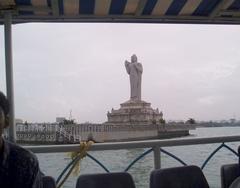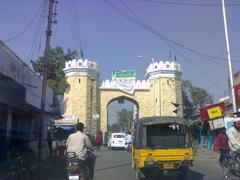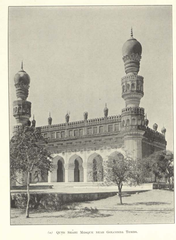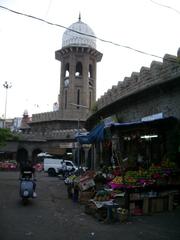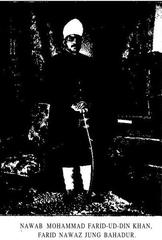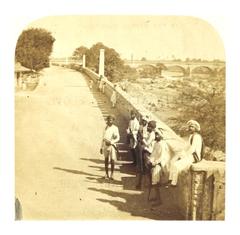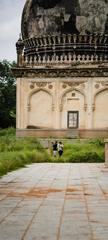Jagannath Temple Hyderabad: Visiting Hours, Tickets, History & Cultural Significance
Date: 03/07/2025
Introduction
Hyderabad’s Jagannath Temple, set amidst the upscale Banjara Hills, stands as a remarkable testament to the enduring spiritual, architectural, and cultural legacy of Odisha in Telangana’s cosmopolitan capital. Established by the Odia diaspora and consecrated in 2009, the temple is a faithful modern replica of the iconic Jagannath Temple in Puri, Odisha. It features the classic Kalinga architectural style, with a towering 70-foot red sandstone shikhara and intricate stone carvings. The temple is not just a sacred place of worship for Lord Jagannath, his siblings Balabhadra and Subhadra, but also a vibrant center for the Odia community, hosting festivals, cultural events, and community outreach. This guide provides comprehensive details on the temple’s history, architectural highlights, religious significance, visiting hours, ticketing, accessibility, and travel tips—ensuring a meaningful and well-informed experience for every visitor. For the most up-to-date information, refer to the official temple website and curated travel resources (The Travel Shots).
Table of Contents
- Origins & Historical Development
- Architectural Features & Symbolism
- Cultural Significance & Community Role
- Major Festivals & Daily Rituals
- Visiting Hours, Tickets, & Accessibility
- Travel Tips & Nearby Attractions
- FAQs
- Conclusion
- References
Origins & Historical Development
The Jagannath Temple Hyderabad was conceptualized in 1992 by a collective of Odias residing in Hyderabad who sought to recreate their sacred traditions in a new land. After years of ceremonies and community efforts, construction began in earnest in 2004, led by skilled artisans from Odisha. The temple was completed and consecrated in March 2009 under the stewardship of the Kalinga Cultural Trust, established to preserve Odia culture in Telangana (Wikipedia; shrijagannathtemplehyderabad.com).
Architectural Features & Symbolism
Kalinga Architectural Style
- Shikhara: The temple’s 70-foot shikhara (spire), constructed from 600 tonnes of red sandstone, is a visual landmark and symbolic of spiritual ascent (Wikipedia).
- Complex Layout: The temple includes the sanctum (Vimana/Devla), assembly hall (Mukhashala/Jagan Mohan), Nata Mandir for dance, and Bhoga Mandap for offerings.
- Intricate Carvings: Exteriors and interiors are adorned with detailed stonework depicting deities, mythological scenes, and the Dasha Avatar (ten incarnations of Vishnu).
- Subsidiary Shrines: Dedicated shrines for Ganesh, Hanuman (Anjaneya Swamy), Maa Vimala, Maa Laxmi, Lord Shiva (Kasi Viswanath), and the Navagrahas.
Symbolism
The temple’s design, iconography, and rituals are deeply rooted in Odia traditions and serve as a bridge between Odisha’s cultural heritage and the cosmopolitan ethos of Hyderabad. The wooden idols of Lord Jagannath, Balabhadra, and Subhadra, with their distinctive large eyes and expressive features, embody inclusivity and the all-encompassing nature of divinity (thetravelshots.com; organiser.org).
Cultural Significance & Community Role
Odia Community Hub
Managed by the Kalinga Cultural Trust, the temple is a cultural nucleus for Hyderabad’s Odia population. It regularly organizes festivals, language classes, classical dance and music performances, and religious workshops, fostering cultural continuity and unity among the diaspora (shrijagannathtemplehyderabad.com).
Inclusivity
The temple is known for its open-door policy, welcoming devotees of all backgrounds. Its major festivals, especially Rath Yatra, attract people from diverse communities, reinforcing the values of unity and equality (Wikipedia).
Major Festivals & Daily Rituals
Rath Yatra (Chariot Festival)
The annual Rath Yatra is the temple’s most celebrated festival, mirroring the grandeur of the Puri event. Distinctively decorated chariots for each deity are pulled in a vibrant procession, signifying the Lord’s journey among his devotees. This festival is marked by devotional singing, community participation, and a spirit of inclusivity (poojn.in; shrijagannathtemplehyderabad.com).
Other Major Festivals
The temple also celebrates Janmashtami, Snana Yatra, Ganesh Chaturthi, Diwali, Kartik Purnima, Mahabishuva Sankranti, and more—each with unique rituals and community feasts (bloggymaster.com).
Daily Rituals
- Mangala Aarti (morning worship)
- Sakala Dhupa (morning food offering)
- Madhyana Dhupa (midday offering)
- Sandhya Dhupa (evening worship)
- Badasinghara Besha (night adornment)
These ceremonies, accompanied by Vedic chanting and incense, are open for visitor participation (pilgrimagetour.in).
Visiting Hours, Tickets, & Accessibility
- Opening Hours: 6:00 AM – 12:00 PM & 5:00 PM – 9:00 PM daily (holidify.com; hyderabadtourism.travel)
- Entry Fee: Free. Donations are welcomed.
- Accessibility: The temple provides ramps and assistance for differently-abled visitors, with ample parking and proximity to public transport.
- Dress Code: Modest, traditional attire is encouraged. Footwear must be removed before entry.
- Photography: Usually not permitted inside; seek permission for photography in designated areas (bloggymaster.com).
Travel Tips & Nearby Attractions
- Best Time to Visit: Early mornings, late evenings, or during major festivals for vibrant celebrations.
- Transport: The nearest metro is Jubilee Hills Check Post; key bus routes include 127K and 47D.
- Nearby Attractions:
- KBR National Park (nature walks)
- Sri Venkateswara Swamy Temple (Jubilee Hills)
- Golconda Fort (7.4 km)
- Charminar (11.4 km)
- Salar Jung Museum
(poojn.in)
Frequently Asked Questions (FAQs)
Q1: What are the temple’s visiting hours?
A1: 6:00 AM – 12:00 PM and 5:00 PM – 9:00 PM daily.
Q2: Is there any entry fee?
A2: No, entry is free for all.
Q3: Can non-Hindus visit?
A3: Yes, all visitors are welcome.
Q4: Is photography allowed?
A4: Generally not inside the sanctum; confirm with temple staff.
Q5: What is the dress code?
A5: Modest, traditional attire is recommended.
Q6: How can I reach using public transport?
A6: Nearest metro: Jubilee Hills Check Post; buses 127K and 47D serve Banjara Hills.
Q7: Are there special guided tours?
A7: Informal explanations are often provided by priests and volunteers; group tours can be arranged in advance.
Conclusion
Jagannath Temple Hyderabad offers a harmonious blend of spiritual devotion, artistic grandeur, and community vitality. From its striking Kalinga architecture and sacred rituals to its inclusive festivals and cultural programs, the temple stands as a beacon of Odia heritage and pluralistic values in urban Hyderabad. Whether you seek spiritual solace, cultural immersion, or architectural inspiration, the temple promises a rewarding and memorable visit. For the latest updates, refer to the official website and trusted guides such as Poojn.in.
Enhance your journey with the Audiala mobile app for curated audio guides and up-to-date travel insights.
References & Official Links
- Jagannath Temple Hyderabad Official Website
- Wikipedia: Jagannath Temple, Hyderabad
- The Travel Shots: Jagannath Temple Hyderabad Guide
- Organiser.org: Bhagwan Jagannath Rath Yatra Significance
- Poojn.in: Jagannath Temple Hyderabad Visitor Guide
- Bloggymaster.com: Jagannath Temple Hyderabad Timings
- Holidify: Sri Jagannath Temple Sightseeing
- Hyderabad Tourism: Jagannath Temple Hyderabad
- Our Temples Inc Wordpress: Best Temples in Hyderabad
